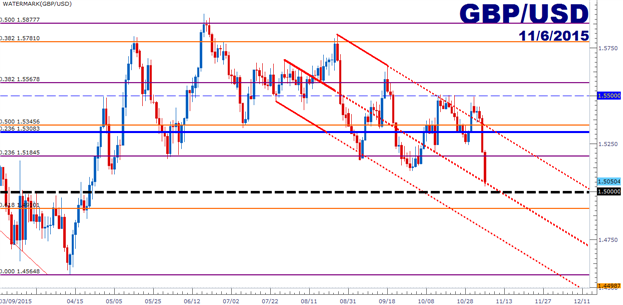To receive James Stanley’s analysis directly via email, please SIGN UP HERE
Talking Points:
- GBP/USD Technical Strategy: Flat, short setup cleared first three profit targets
- After a precipitous drop, traders should urge caution if chasing the down-trend, as a light week of upcoming data may bring congestion and retracements in especially fast-moving markets (as we’ve seen in the Cable) .
- With such an important psychological level less than 50 pips away, traders can use this to build their approach for the coming week; playing reversals should support develop above this level, or trend-continuation with breaks below.
In our last article, we looked at the convoluted price action in GBP/USD to begin the week ahead of the Bank of England’s Super Thursday trifecta of data releases. And while the Bank of England didn’t take on the hawkish tone that many had expected, they certainly provided enough ammunition for markets to put in some break-neck moves to finish the week, and this led to massive weakness in GBP price action across the FX market.
The first three targets for the short-setup mentioned in that article have been met, and only the fourth target at 1.5000 remains. This could prove daunting for new short-side positions, as 1.5000 is a major psychological level that could have a tendency to bring new buyers into the market; and this could create considerable discord for trend-continuation strategies. As a matter of fact, this 1.5000 level may potentially be operative for reversal strategies for those that are looking to fade this recent bout of USD-strength on the back of a really robust jobs report.
The top-side reversal setup on GBP/USD would likely need to be accompanied by confirmation of support, as buying in this market right now would be like trying to catch a javelin (which rarely works out well). But should support develop in this 1.5000 area in the first couple of days of next week, this could provide motive for reversal strategies; and this would open the door for targets at 1.5106 (the October swing-low), 1.5184 (the 23.6% retracement of the most recent major move, taking the 2014 high to the 2015 low), and then 1.5250, which is another major psychological level as well as a projection of top-side of the downward sloping trend-channel (shown below in red).
On the short side, traders can utilize a two-pronged approach in looking to jump on the trend in the most efficient manner possible. Traders can look for ‘inside price action’ by waiting for prices to retrace to a potential resistance level, and this can often come in at new support or a level that had previously functioned as resistance. For this purpose, the first two levels mentioned above could prove adequate; using 1.5106 or 1.5184 to trigger additional short-side entries. Should 1.5250 come back in the market, that could prove troublesome for shorts, as the down-trend will come into question should this trend-channel give way. Traders picking up shorts with inside price action can look for targets at that 1.5000 psychological level, and then 1.4910, which is the 61.8% retracement of the ‘secondary move’ in the Cable, taking the Financial Collapse low to the 2014 high), and then the next major psychological level of 1.4750.
Alternatively, traders can use ‘outside price action’ to attempt to follow the down-trend. This could be the implementation of a breakout strategy below support levels (such as selling on a break of 1.4910), or by utilizing a hybrid of a breakout and a trend entry. To do this, traders can wait for a break of any of the support levels mentioned above, and if this happens, move down to a lower-time frame chart to try to ‘sell expensively,’ waiting for new resistance to develop in an area of old support. This would enable the trader to take a concentrated risk amount of an entry in a market experiencing a breakout.

Created with Marketscope/Trading Station II; prepared by James Stanley
--- Written by James Stanley, Analyst for DailyFX.com
To receive James Stanley’s analysis directly via email, please SIGN UP HERE
Contact and follow James on Twitter: @JStanleyFX







